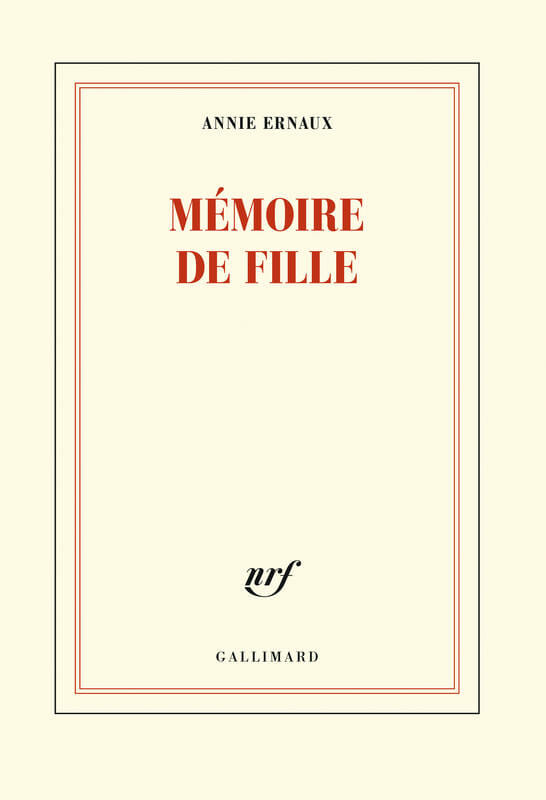
A Girl's Story by Annie Ernaux | The processing of trauma
Length
What is the point of writing after all if not to unearth things, maybe even just one thing?
A Girl’s Story, Annie Ernaux
Constantly unearthing the wreckage of the past is what Annie Ernaux does in her writing; in fact, she was awarded the Nobel Prize for Literature in 2022 “for the courage and clinical acuity with which she uncovers the roots, estrangements, and collective bonds of personal memory.” Before the Nobel Prize, she received other awards for three consecutive years: The European Strega Prize in 2016, the Marguerite Yourcenar Prize for career achievement, and in 2018 the Hemingway Prize for Literature.
Ernaux’s best-known titles include A Frozen Woman (1981), Happening (2000) from which a Golden Lion-winning film was made, and The Years (2008). But the most masterful example of the author’s idea of memory and its cathartic use is found in A Girl’s Story, published in 2016 by Gallimard. In this book, the French writer recalls the summer of 1958, a crucial period of her growth that she is only able to make sense of through writing and remembering 58 years later.

Mémoire de fille first edition, Gallimard, 2016.
A journey of self-discovery
The narrative is moved by the observation of a photograph depicting young Annie at school. Annie, now 58, tries to bring back memories of the distant summer of 1958, a crucial time of growing up. The transition to adulthood is a delicate theme explored by several authors, such as J.D Salinger‘s The Catcher in the Rye, Niccolò Ammaniti‘s I’m Not Scared, and Jane Teller‘s Nothing.
At 18, Annie breaks away from her family and finds herself alone with the outside world when she serves as a teacher and instructor at a vacation camp. There, she falls in love for the first time with an older boy, H., who will break her heart and take away her dignity. For the first time, Annie discovers the other’s body in a sexual sense, desire, and the world as it is outside Yvetot, her small hometown. She will struggle with love, sex, the judgment of others, and even eating disorders, and the clash will be abrupt and remain a trauma for a long time.
A Girl’s Story
The original title of A Girl’s Story seems to echo the original work of Simone de Beauvoir‘s Memoirs Of a Dutiful Daughter in both title and memoristic genre. Yet, despite being a fan of de Beauvoir, Ernaux emphasized the difference between her book and that of her idol. In A Girl’s Story, memory is in the singular, unlike the title of the famous French philosopher and writer, precisely because Ernaux wants to make herself the bearer of a universal experience, of a moment in life that everyone goes through and which everyone can recognize.
In her book, Ernaux relives that crucial age of existence filled with questions characterized as “Who will I be? What will do in the world? What job?”, a phase in which one discovers the other sexually and goes in search of oneself. For the protagonist, that summer, along with all the painful experiences it brought with it, constituted the focal point of her life that later determined her work as a writer, and her relationship with men, and generally affected her future. In the book, the author finally remembers, analyzes, understands, and names those experiences she could not understand as a teenager.

Young Annie Ernaux.
Style and language
In A Girl’s Story the language is colloquial and simple, the writing direct and fluid, and Ernaux engages the reader in an everyday routine with which one can easily identify. The narrator is in the third person and it is the writer herself who, faced with the discovery of an old photo, begins a journey of identification with her adolescent self. In fact, at first, the narrator says that she does not recognize herself in that little girl, and only after talking about herself will she be able to say “It’s me, it’s her.” The third person was necessary to catch the teenage girl in her reality with detachment and be able to tell about her, as the writer herself revealed in an interview with Rai Cultura:
“I have to observe her from a distance. It is a position that in the end allowed me to go farther, that allows me to take a distance and therefore freedom.”
Also during the same interview, Ernaux explains why she uses the photo device:
“Photography renders the feeling of time fleeing (…) it contains, it measures, the depth of time.”
The autobiography of pain
A similar operation of memoiristic writing but on canvas is accomplished by Frida Kahlo. The Mexican painter is known not only for her highly personal surrealist style that has become iconic but also for the way her painful autobiographical narrative is put on canvas. In the painting The Two Fridas (1939), for example, Frida depicts two versions of herself in a moment of suffering after her divorce from her husband. In her 1938 painting What the Water Gave Me, the theme of memory and personal experience is even more central: in the reflection of the water of the bathtub, Frida shows all the most important events of her life.
Memory recollected in tranquility
In A Girl’s Story, Ernaux dusts off the memory boxes of her eighteen years and, step by step, with accuracy, recounts the experiences, details, and feelings of that crucial period of her life that she never dared to face before.
“I don’t construct a fictional character; I deconstruct the girl I was.” What Ernaux does is deconstruct that dramatic period through recollection and writing. These two tools allow her to give deep meaning to the past experiences that determined her present. Writing, for Ernaux, helps to “understand and endure what happens and what we do” as well as being “an instrument of knowledge of the real.”
Thus, Ernaux’s writing in Mémoire de fille becomes what poetry is to the poet William Wordsworth that is the result of certain memories and emotions that are recollected in “tranquility,” after years, in a calm mental state.
Tag
Buy a ☕ for Hypercritic









